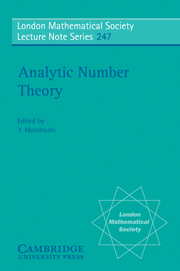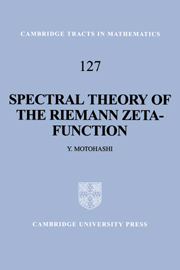18 results

Analytic Number Theory
-
- Published online:
- 08 April 2010
- Print publication:
- 16 October 1997
16 - Trace Formula over the Hyperbolic Upper Half Space
-
-
- Book:
- Analytic Number Theory
- Published online:
- 08 April 2010
- Print publication:
- 16 October 1997, pp 265-286
-
- Chapter
- Export citation
Contents
-
- Book:
- Analytic Number Theory
- Published online:
- 08 April 2010
- Print publication:
- 16 October 1997, pp v-vi
-
- Chapter
- Export citation
Foreword
-
-
- Book:
- Analytic Number Theory
- Published online:
- 08 April 2010
- Print publication:
- 16 October 1997, pp vii-viii
-
- Chapter
- Export citation
Frontmatter
-
- Book:
- Analytic Number Theory
- Published online:
- 08 April 2010
- Print publication:
- 16 October 1997, pp i-iv
-
- Chapter
- Export citation
Speakers
-
- Book:
- Analytic Number Theory
- Published online:
- 08 April 2010
- Print publication:
- 16 October 1997, pp ix-x
-
- Chapter
- Export citation
4 - An explicit formula
-
- Book:
- Spectral Theory of the Riemann Zeta-Function
- Published online:
- 05 November 2011
- Print publication:
- 11 September 1997, pp 144-184
-
- Chapter
- Export citation
Author index
-
- Book:
- Spectral Theory of the Riemann Zeta-Function
- Published online:
- 05 November 2011
- Print publication:
- 11 September 1997, pp 225-226
-
- Chapter
- Export citation
Convention and assumed background
-
- Book:
- Spectral Theory of the Riemann Zeta-Function
- Published online:
- 05 November 2011
- Print publication:
- 11 September 1997, pp viii-x
-
- Chapter
- Export citation
5 - Asymptotics
-
- Book:
- Spectral Theory of the Riemann Zeta-Function
- Published online:
- 05 November 2011
- Print publication:
- 11 September 1997, pp 185-220
-
- Chapter
- Export citation
Frontmatter
-
- Book:
- Spectral Theory of the Riemann Zeta-Function
- Published online:
- 05 November 2011
- Print publication:
- 11 September 1997, pp i-iv
-
- Chapter
- Export citation
1 - Non-Euclidean harmonics
-
- Book:
- Spectral Theory of the Riemann Zeta-Function
- Published online:
- 05 November 2011
- Print publication:
- 11 September 1997, pp 1-42
-
- Chapter
- Export citation
Contents
-
- Book:
- Spectral Theory of the Riemann Zeta-Function
- Published online:
- 05 November 2011
- Print publication:
- 11 September 1997, pp v-vi
-
- Chapter
- Export citation
Subject index
-
- Book:
- Spectral Theory of the Riemann Zeta-Function
- Published online:
- 05 November 2011
- Print publication:
- 11 September 1997, pp 227-228
-
- Chapter
- Export citation
References
-
- Book:
- Spectral Theory of the Riemann Zeta-Function
- Published online:
- 05 November 2011
- Print publication:
- 11 September 1997, pp 221-224
-
- Chapter
- Export citation
3 - Automorphic L-functions
-
- Book:
- Spectral Theory of the Riemann Zeta-Function
- Published online:
- 05 November 2011
- Print publication:
- 11 September 1997, pp 97-143
-
- Chapter
- Export citation
2 - Trace formulas
-
- Book:
- Spectral Theory of the Riemann Zeta-Function
- Published online:
- 05 November 2011
- Print publication:
- 11 September 1997, pp 43-96
-
- Chapter
- Export citation

Spectral Theory of the Riemann Zeta-Function
-
- Published online:
- 05 November 2011
- Print publication:
- 11 September 1997



